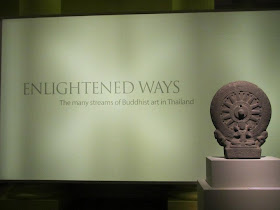 |
| Bodhi tree. Dvaravati culture, 8th century. Limestone. From National Museum, Bangkok. |
Enlightened Ways: The Many Streams of Buddhist Art in Thailand
30 Nov 2012 - 17 Apr 2013
Special Exhibitions Gallery
Asian Civilisations Museum Empress Place
1 Empress Place
Singapore 179555
Tel: (+65) 6332 7798, (+65) 6332 3275
My first visit to the exhibition, Enlightened Ways: The many streams of Buddhist art in Thailand, was in late Dec 2012. I did not check the time for the guided tour before making that visit and had missed the guided tour for that day. While the artefacts featuring Buddhist Art in Thailand appeared well crafted, I did not know how to appreciate them except for their pure aesthetic value.
I wasn't quite sure how to start appreciating the history of Buddhist art in Thailand. All I could figure out from the brochure was that Buddhism arrived from India to Thailand before the 5th century. I could not quite make sense of the significance of the artefacts on display during that visit.
 |
| On the right, Wheel of the Law. Dvaravati culture, 7th or 8th century. National Museum, Bangkok. |
Feeling almost clueless after my first visit to Enlightened Ways: The many streams of Buddhist art in Thailand, I decided to make my second visit to the exhibition recently. I do not consider myself to be interested in Buddhist art because I do not understand enough about it to appreciate it. Nevertheless, I thought to myself that visiting the exhibition yet again is a way to enable myself to learn at least one thing new about Buddhist art in Thailand. Before that visit, I checked the museum's website for information on the guided tours to this exhibition. Here are the schedules:
Guided tours:
Meeting point: ACM lobby
English tour:
Tuesday to Friday: 12.30 p.m.
Saturday and Sunday (starts 5 Jan 2013): 3.30 p.m.
Chinese tour:
Saturday and Sunday (starts 5 Jan 2013): 3 p.m.
Japanese tour:After the visit, I learnt that the Buddhist art in Thailand reflects a combination of elements of other religions (such as Brahmanism) and local customs.
Tuesday to Friday 1.00 p.m.
If I have understood the guide well, I learnt that early Buddhist art did not focus on depicting the human forms. Instead, early Buddhist art focused on objects that would reflect the philosophy behind Buddhism.
Through this exhibition, I learnt that in Lopburi (central Thailand) from the 11th to 13th century, the concept of worshipping kings as gods was established. This concept was subsequently assimilated by the later Thai kingdoms.
There was a statue of a Walking Buddha from the Sukhothai kingdom from the 15th or 16th century that had captured my attention. The statue radiated an aura of calming peace. The form of the walking Buddha was crafted in a most refined manner such that my eyes perceived the statue to be walking and was able to come to a stand. I learnt from the guided tour that the form of the Walking Buddha was very common during the Sukhothai period.
 |
| Group of finials with the four-headed Brahma. Rattanakosin period, 19th century. Central storage, Office of National Museums. |
The exhibition reminded me that Brahmanism, an early form of Hinduism, has had a profound effect on Thai art. I was told that sculptures of Hindu gods could be seen guarding Buddhist temples. Our guide shared with the participants interesting stories about a few of the Hindu gods, for example, Ganesha.
Buddhist art from the Rattanakosin period (1782 - present) appeared to reflect influences from China and Europe. Our tour guide highlighted to us an elephant seat from the Rattanakosin period. The design on the elephant seat clearly reflected Chinese motifs and influences. I learnt that the start of the 19th century, there has been increasing trade with China.
Even though I do not consider myself well-versed in Buddhist art after making two visits to this exhibition, I felt that I was more exposed and slightly more informed about Buddhist art in Thailand. My heartfelt appreciation to our guide as well as the various organizations who have made this exhibition possible. An exhibition that you could consider especially if you are open to learn about Buddhist art in Thailand. Check this out soon as this exhibition will end on 17 Apr 2013.
No comments:
Post a Comment